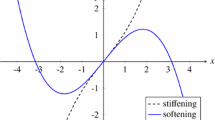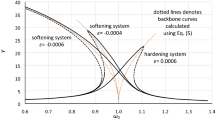Abstract
We analyze the dynamics of the forced singularly perturbed differential equation of Duffing’s type. We explain the appearance of the large frequency nonlinear oscillations of the solutions. It is shown that the frequency can be controlled by a small parameter at the highest derivative. We give some generalizations of results obtained recently by B. S. Wua, W. P. Suna, and C. W. Lim. Analytical approximations to the double-well Duffing oscillator in large amplitude oscillations (see J. Sound Vibration 307 (2007), Nos. 3–5, 953–960). A new method for an analysis of the nonlinear oscillations which is based on the dynamic change of coordinates is proposed.
Similar content being viewed by others
References
N. Fenichel, Geometric singular perturbation theory for ordinary differential equations. J. Differ. Equations 31 (1979), 53–98.
V. Gaitsgory and G. Grammel, On the construction of asymptotically optimal controls for singularly perturbed systems. Systems Control Lett. 30 (1997), Nos. 2–3, 139–147.
F. Herzel and B. Heinemann, High-frequency noise of bipolar devices in consideration of carrier heating and low temperature effects. Solid-State Electronics 38 (1995), No. 11, 1905–1909.
C. Jones, Geometric singular perturbation theory. Lect. Notes Math. 1609, Springer-Verlag, Heidelberg (1995).
M. Krupa and P. Szmolyan, Relaxation oscillation and canard explosion. J. Differ. Equations 174 (2001), No. 2, 312–368.
N. M. Krylov and N. N. Bogoliubov, Introduction to nonlinear mechanics. Princeton Univ. Press (1947).
P. Mei, C. Cai, and Y. Zou, A generalized KYP lemma-based approach for H ∞ control of singularly perturbed systems. Circuits Systems Signal Process. 28 (2009), No. 6, 945–957.
J. Sanders, F. Verhulst, and J. Murdock, Averaging methods in nonlinear dynamical systems. Springer-Verlag, New York (2007).
R. Srebro, The Duffing oscillator: a model for the dynamics of the neuronal groups comprising the transient evoked potential. Electroencephalography Clinical Neurophysiology, 96 (1995), No. 6, 561–573.
B. S. Wua, W. P. Suna, and C. W. Lim, Analytical approximations to the double-well Duffing oscillator in large amplitude oscillations. J. Sound Vibration 307 (2007), Nos. 3–5, 953–960.
Y. Ye, L. Yue, D. P. Mandic, and Y. Bao-Jun, Regular nonlinear response of the driven Duffing oscillator to chaotic time series. Chinese Phys. B 18 958, (2009); doi: 10.1088/1674-1056/18/3/020.
Author information
Authors and Affiliations
Corresponding author
Rights and permissions
About this article
Cite this article
Vrabel, R., Abas, M. Frequency control of singularly perturbed forced duffing’s oscillator. J Dyn Control Syst 17, 451–467 (2011). https://doi.org/10.1007/s10883-011-9125-0
Received:
Revised:
Published:
Issue Date:
DOI: https://doi.org/10.1007/s10883-011-9125-0




